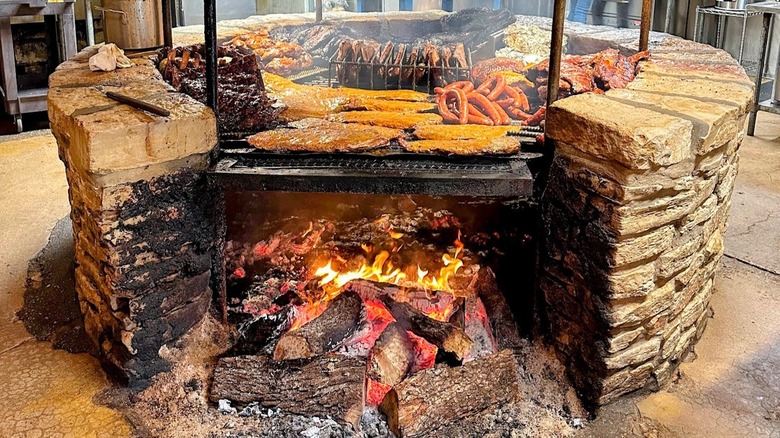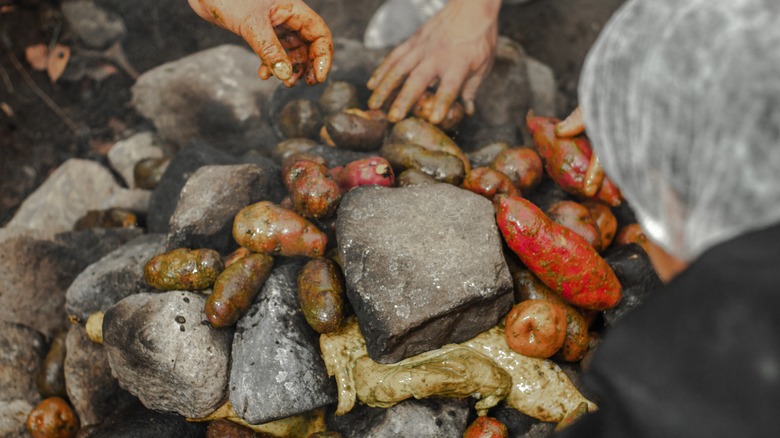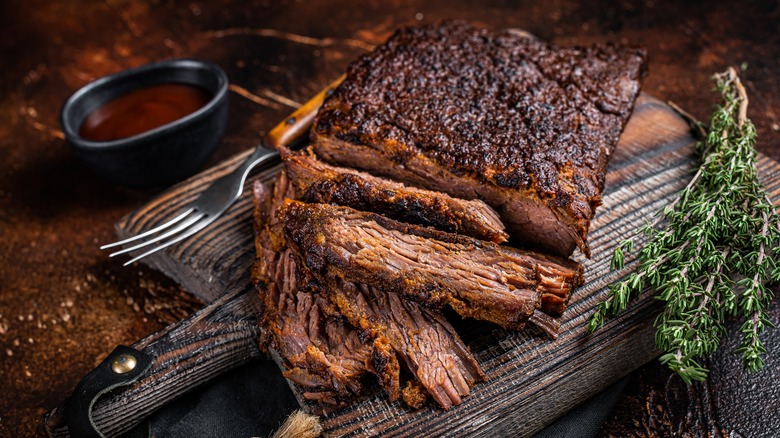The Historic Roots Of Pit-Cooked Barbecue
For many, a special kind of magic emerges when meat meets fire. It's a deep-rooted love affair that traces back through the history of cooking — and to the origins of humanity itself. Humans have been placing foods onto fire for an astounding 2 million years. The process then became more carefully arranged into an organized hearth around 400,000 years ago.
Fire-based cooking techniques evolved further with the creation of the earth oven, the earliest evidence of which traces to a site in Central Europe in 29,000 B.C. This large roasting setup — which also came with a section for boiling — showcases an early barbecue feast, with remains of mammoth, deer, and several other animals. Such an earth oven method entails the digging of a hole, inside which wood is burned into coals. Next, foodstuffs, especially meats, are wrapped in a material and placed inside, with the top covered by a hefty lid. Then, it's all slow-cooked inside the smoky chamber, until tender and flavorful.
It may all sound reminiscent of barbecue — that's because it is. This technique is analogous to pit-cooked barbecue. From its thousands-of-years-old roots, the method still exists, showcased in regional American barbecue styles like Baltimore's pit beef, barbacoa from South Texas, and Hawaii's whole-pig Kalua. It's an ancient style with many global influences, producing a deeply flavorful result with a far-reaching history.
Pit-cooked barbecue has been practiced globally for centuries
After its earliest iteration over 30,000 years ago, the pit-cooking style spread worldwide. Archaeological evidence suggests the method was prevalent in Northern Europe from the third to sixth centuries, before being replaced by other techniques. It is a centuries-old practice still enjoyed across Pacific cultures.
When the Maoris arrived in New Zealand around the 14th century, they introduced the hangi cooking method to foods found on the island. This technique builds upon a charcoal-lined pit, but can also use geothermal springs — a unique twist. Elsewhere across Oceania, earth ovens continue to be a prominent cooking style. In Polynesia, they've been a daily cooking source since around A.D. 1450. Most adhere to the technique's subterranean format, but Samoans have shifted the pit method above ground, cooking fish, meats, and vegetables wrapped in banana leaves over hot volcanic rocks in a style called umu.
The method also has deep roots in the Americas. In Peru, a comfort food called pachamanca involves pit-cooked marinated meats, classically wrapped in chincho leaves. It's an enduring style dating back over 7,000 years. And there's evidence of the technique in North American civilizations, too. Native Americans in California employed the style for local fauna, while indigenous people in Texas used earth ovens for plants like sotol and agave. The method was practiced in the Caribbean, too, with the Taíno people using pit cooking for meats. This deep-rooted tradition especially contributed to the American barbecue we know today.
American pit-cooked barbecue fused indigenous techniques with European ingredients
Far-reaching and ancient, pit-cooking embraces local ingredients and traditions. It can also mingle together varying influences — a phenomenon especially showcased in American barbecue. Even the name "barbecue" itself likely originates from the indigenous word barbacoa, which can refer either to a wood-constructed smoking apparatus, or the ubiquitous fire-pit.
Spanish explorers came into contact with the technique, adopting both the word and the preparation method. From there, European-tinged pit-style barbecue spread across North America, involving meats like beef and pork, which did not exist in the New World. In Mexico, the process mingled with Mayan techniques to create barbacoa. Abundant native agave leaves are utilized in this style, combined with Spanish introductions like different types of beef for a tender and flavorful barbacoa.
Meanwhile, in the U.S., pit-cooked barbecue also took on influences from enslaved Africans, producing dishes like whole pigs cooked underground. During the 20th century, many of these Southern methods were adapted to above-ground smokers and charcoal grills, leaving old-school pit methods behind.
There are a few regional barbecue locales, especially in Texas, where true pit-cooked barbecue continues. In the south of the state, pits are used to make creations akin to Mexican barbacoa, while in the central region, pit-style barbecue combines Central European influences with distinctly homegrown techniques. So, dip into one of these four Texan barbecue styles to try out a mouthwatering method that traces back thousands of years.


